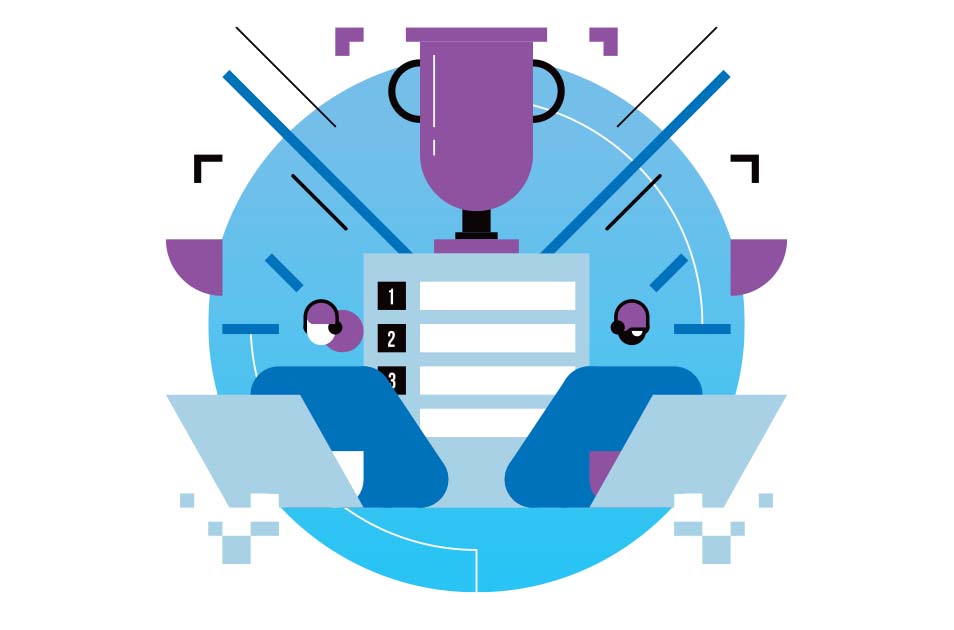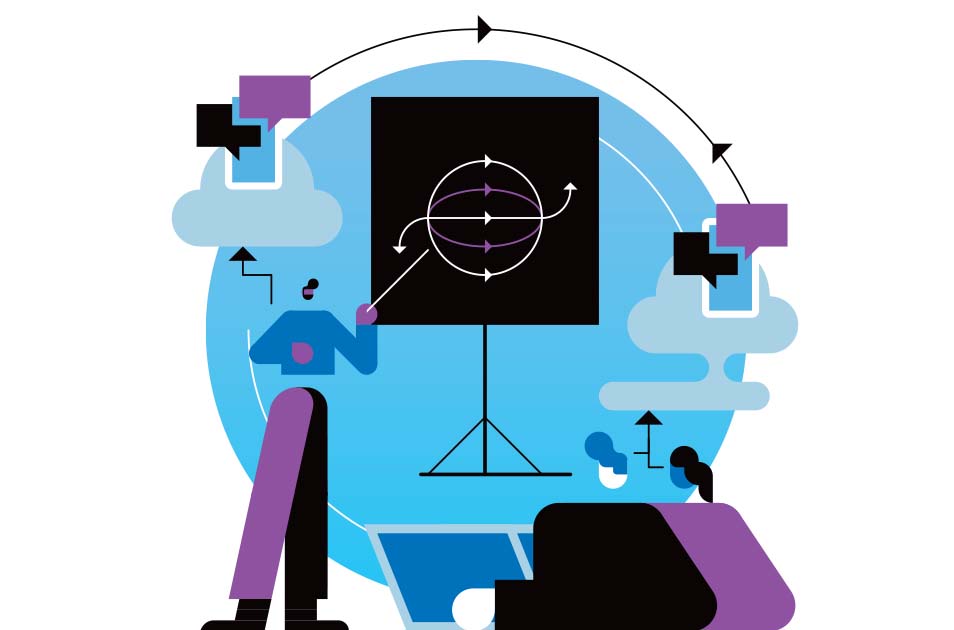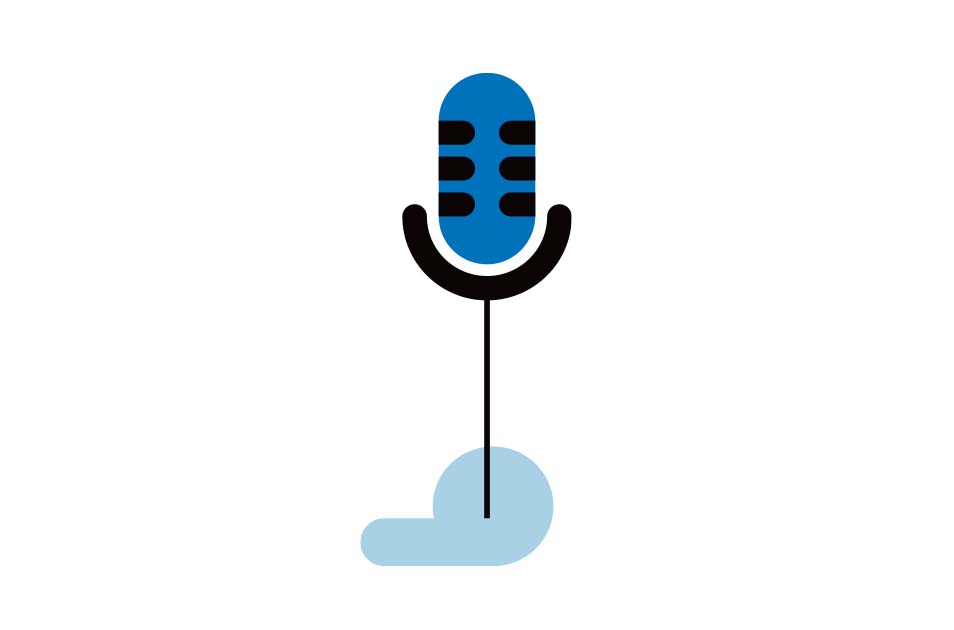Published: July 27, 2023
Technology Revolution = Education Evolution

UT leans into tech’s changes and challenges to enhance students’ critical thinking, motivation and learning experiences in and out of class
By Daniel Oberhaus | Illustration by blindSALIDA
Last November, education changed forever when OpenAI, an artificial intelligence research and development organization, released its ChatGPT app to the public.
The sophisticated AI tool allows users to hold conversations with the computer program in natural language and instruct it to write essays and emails, summarize documents, write computer code, translate articles and much more. Within weeks, ChatGPT had amassed more than 100 million users, making it the fastest-growing consumer app in history, outpacing even social media phenomena like Facebook and TikTok.
Reactions to the program ranged from exuberance to terror. Some saw ChatGPT as a way to turbocharge human creativity, while others saw it as an existential threat to human civilization. But regardless of whether you loved ChatGPT or hated it, there was no ignoring it — especially in the classroom. It wasn’t long before students worldwide, including at The University of Tampa, started using the tool to complete homework assignments with minimal effort, blowing open the door to a fraught debate about the appropriate use of ChatGPT and similar AI tools in higher education.
“When ChatGPT came out, I started sweating,” said Assistant Professor of Education Suzanne Ensmann, a sentiment that was echoed by her research collaborator, Professor of English and Writing Aimee Whiteside: “I’m not going to lie, ChatGPT has thrown us all for a loop,” she said.
And yet, Ensmann, Whiteside and their colleagues across the University have pulled together to not just overcome the challenges posed by ChatGPT but seize an unprecedented opportunity to leverage a powerful new technology to improve the educational experiences and outcomes for their students.
One of the biggest challenges posed by ChatGPT in classrooms is that it opens new avenues for academic integrity violations. For educators, the problem is that a paper written by ChatGPT and a paper written by a student will look almost identical. “With ChatGPT, now when I’m reading a paper I’m wondering if I’m wasting my time checking the AI’s work rather than a student’s learning,” said Ensmann.
ChatGPT is good, but it’s not perfect. Both Ensmann and Whiteside have used other technology and a commitment to transparency to undermine its use. For example, their students now complete many of their assignments in Google Docs, which allows Ensmann and Whiteside to monitor their writing in real-time and track changes to the document. If a student pastes a big block of text into the document, there’s a chance it was penned by ChatGPT, and they can talk with the student. But more importantly, both Ensmann and Whiteside are committed to having open conversations with their students about the limitations of the app.
“I tell my students every day that they are much better than this technology,” said Whiteside. “You need to learn to strengthen those writing muscles, so you can take the skills that you’re learning into the world and be a problem solver.”
Earlier this year, Cheri Etling-Paulsen, the associate dean of the Center for Teaching and Learning, spearheaded a working group of professors from across the UT colleges to better understand how they and their students are adapting ChatGPT in the classroom. While many UT faculty members are understandably concerned about how AI might undermine students’ learning, she says many professors are also finding creative ways to use ChatGPT to enhance their students’ education. As an example, she cited a physics professor who used ChatGPT to write creative vignettes to help students understand challenging physics problems on exams. Another professor allows students to use ChatGPT to write basic computer code so they can improve their ability to audit and troubleshoot software programs.
“I think in the long run ChatGPT will be really beneficial because it means we can focus more on ideas and critical thinking, rather than rote memorization,” said Etling-Paulsen. “I think we need to be very careful about telling our students that they can never use this tool. We need to step back and really think about what we want our students to be able to do for society.”
Although Etling-Paulsen acknowledges that ChatGPT is the “hot topic” in higher ed, it’s just one of many new technologies that UT professors are using to improve the student experience. All these efforts are focused on technologies that students are already using in “the real world” and applying them to instruction. Today’s students are fluent in the language of the internet and technology, and educators can leverage this fluency to improve learning outcomes by using digital games, social media, podcasts and other tools.

GAMIFYING EDUCATION
Gaming has deep roots in the cybersecurity industry, where companies and governments frequently host “capture the flag” competitions where groups of hackers compete to gain access
to an opponent’s computer system while defending their own. The goal of these exercises is to mimic real-world hacking scenarios and give cybersecurity professionals hands-on experience with managing a security breach. But despite the importance of these games for professional development, gamification is not typically integral to students’ classroom learning experience. In 2021, Chen Zhong, assistant professor of cybersecurity, and Joo Baek Kim, assistant professor of information and technology management, set out to change that.
Funded by a grant from the University, Kim and Zhong launched a research program that gamified their existing course materials to determine whether adding a competitive element to the cybersecurity curriculum would help their students learn. The duo used an online gamification platform called Gametize and converted lessons from one of Zhong’s classes into mini-games. In one module, for example, students are asked to analyze network attacks and attempt to crack Wi-Fi passwords to understand the types of information an attacker can collect if they gain access to a wireless network. The students earn points on the platform based on their performance and can see their ranking on a student leaderboard.
“We wanted to see whether this was effective and whether the implementation effort was worth it,” said Zhong, who is the first to admit that gamification doesn’t make sense for every type of lesson. “Students really liked it — they tended to complete assignments earlier and it had a positive impact on their motivation and career interests.”
For Ensmann, who has spent much of her career studying gamification in education, this is a major part of what makes tech-driven games such a useful tool in the classroom. “They’re highly motivational,” she said. “More studies need to be completed to determine how gamification impacts the outcomes, but if they’re winning the game, they are at least learning soft skills.”

SOCIAL MEDIA CLASSROOMS
Ensmann is a major proponent of gamification in higher education, but like Zhong, she is also acutely aware of its limitations. In March 2020, Ensmann was engaged in a research project on digital game-based learning that was interrupted when the University had to abruptly switch to remote learning in response to the COVID-19 pandemic. Ensmann shifted her focus to studying how students were transitioning. In partnership with several colleagues, they found that, contrary to expectations, the biggest challenge for remote learning wasn’t the online curriculum. It was the isolation.
“The bottom line was that students weren’t complaining about the content of their education; they were complaining about the lack of connection,” said Ensmann. “They felt isolated and felt like they weren’t making connections with the content or the professor — and they really wanted that.”
Following this study, Ensmann partnered with Whiteside to launch a research program on social and gameful experiential (SAGE) learning, which combines Ensmann’s expertise in gamified education with Whiteside’s expertise in social presence in online and hybrid learning environments. Together, they explored a dynamic, community-based platform called Yellowdig that combines leaderboards and other elements of gamification with elements of social media, such as the ability for students to create, like and respond to comments.
“It’s a community model where the entire class is adding to the discussion and creating a great body of knowledge rather than just responding to a teacher’s prompt,” said Whiteside. “Everyone feels a sense of investment in that community, and they’re learning. It pairs really well with the gamification piece.”
Over the course of 2021 and 2022, Whiteside and Ensmann rolled out their SAGE approach to learning in approximately 20 classrooms and studied how it changed student satisfaction, cognition and feelings about learning. Broadly speaking, they found that combining gamification with social media-like functions increased student satisfaction and engagement. For example, rather than making mandatory posts the day before they’re due, students would be more proactive and engaged on the platform throughout the week. The platform allowed students to learn “on the fly,” meaning they were using the platform throughout their day-to-day lives just as they would with any other social media platform such as Instagram or Twitter.
“We’re trying to change the paradigm because this is where the future is going,” said Ensmann. “When students want to learn something, they watch YouTube videos or go on social media. COVID just helped to bring this paradigm within the educational setting through remote learning.”
 PODAGOGY
PODAGOGY
Like Ensmann, Rebecca White, the James W. Walter distinguished chair of entrepreneurship and director of the John B. Lowth Entrepreneurship Center, is a strong advocate for using technology to meet students where they already are learning.
Since 2019, White has hosted a podcast called En Factor where she interviews entrepreneurs from around the world to help teach her students. Case studies and interviews with entrepreneurs have always been a core part of White’s curriculum, but with podcasting, she found a way to streamline this information and deliver it to her students — and the wider world — in an engaging and accessible format.
“More than 60% of people are already listening to podcasts, and most of them say that they listen to podcasts because they want to learn new things,” said White. “My students love it, and it’s a great way to engage with the topics we’re discussing in class because people learn through stories.”
Although White’s podcast started out as a supplement to her classroom instruction, after more than 100 episodes, it has taken on a life of its own. Today, En Factor is both a highly regarded business podcast and the basis of White’s ongoing research into using podcasts as educational tools. White calls her approach “podagogy,” a portmanteau of pedagogy and podcast, and her research shows that it has many advantages when used in tandem with a more conventional entrepreneurial curriculum. Not only does it allow students to continue learning outside the classroom in a familiar format, but it also enables White to continuously update her curriculum to address current events — something that is challenging or impossible to do when students are learning from a textbook.
“Technology is changing so fast — just look at what’s happening with AI,” said White. “We’ll still need textbooks, but when I’m out interviewing entrepreneurs, they’re keeping my students on the cutting edge of everything.”
A HIGH-TECH UNIVERSITY
ChatGPT, gamification, social media and podcasts are only a handful of ways that technology is changing education at UT. Faculty are using VR headsets to show their students how blended reality systems can enhance learning; they’re using AI systems to give students real-time feedback during job interview practice; they’re launching programs teaching them how to code in Python; and they’re reimagining what it means to learn in a remote-first environment with new platforms and curricula.
Ultimately, these are just new tools in an educator’s repertoire that can improve the learning outcomes for all Spartans. Across campus, UT faculty are demonstrating an unparalleled commitment to addressing both the promise and peril of emerging technologies in their classrooms and taking a clear-eyed view of how these technologies affect their students and their future.
“The technology is incredible, and it’s a really rich time to be teaching and learning,” said Whiteside. “But if we just allow technology to solve all our problems, that worries me for the future. What’s fundamentally important is that we’re mindful of how we use it in our classrooms and how it shapes our pedagogical philosophy. Technology is involved, of course, but the main driver should always be cultivating our classroom experience.”
